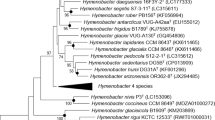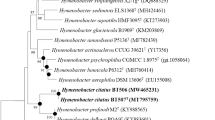Abstract
Strain OR362-8T was isolated from a biological soil crust sample collected from the southwestern arid lands of the United States of America, using BG11-PGY medium. Cells of OR362-8T were found to be rod shaped; occur singly, as pairs and in groups; non-motile; positive for catalase, oxidase, phosphatase and gelatinase; hydrolyze starch; contain iso-C15:0, anteiso-C15:0, iso-C15:1G, C16:1ω5c and summed feature 3 (C16:1(ω7c)/iso-C15:0 2OH as defined by the MIDI system) as the major fatty acids; and MK-7 as the sole respiratory quinone. A BLAST sequence similarity search using 16S rRNA gene sequence of OR362-8T identified Hymenobacter as the nearest genus with a similarity of 90.4–96.9 %. The phylogenetic analyses based on the phenetic methods UPGMA, NJ, ME and DNA parsimony resulted in the clustering of OR362-8T with Clade 1 Hymenobacter species represented by Hymenobacter glaciei, Hymenobacter antarcticus, Hymenobacter flocculans, Hymenobacter metalli and Hymenobacter soli with the closest being the Hymenobacter glaciei (96.9 % 16S rRNA gene sequence similarity). Besides the strong phylogentic affiliation, OR362-8T also exhibited significant phenotypic and chemotaxonomic differences with the members of Clade 1 Hymenobacter spp. More importantly, the DNA G+C content (mol%) of OR362-8T is very high (70 %) compared to the nearest species identified by phylogenetic analysis. Based on the phylogenetic, phenotypic and chemotaxonomic characteristics, OR362-8T was assigned to a novel species for which we propose here the name Hymenobacter arizonensis sp. nov., with OR362-8T (=ATCC BAA 1266T = DSM 17860T = JCM 13504T) as the type strain.



Similar content being viewed by others
References
Aislabie JM, Broady PA, Saul DJ (2006) Culturable aerobic heterotrophic bacteria from high altitude, high latitude soil of La Gorce Mountains (86°30′S, 147°W), Antarctica. Antarct Sci 18:313–321
Arrage AA, Phelps TJ, Bennot RE, White DC (1993) Survival of surface microorganisms exposed to UV radiation and hydrogen peroxide. Appl Environ Microbiol 59:3545–3550
Baik KS, Seong CN, Moon EY, Park YD, Yi H, Chun J (2006) Hymenobacter rigui sp. nov., isolated from wetland freshwater. Int J Syst Evol Microbiol 56:2189–2192
Baker MG, Lalonde SV, Konhauser KO, Foght JM (2010) Role of extracellular polymeric substances in the surface chemical reactivity of Hymenobacter aerophilus, a psychrotolerant bacterium. Environ Microbiol 76:102–109
Bates S, Reddy GSN, Garcia-Pichel F (2006) Exhophiala crusticola anam. nov. a novel black yeast isolated from Colorado Plateau, USA. Int J Syst Evol Microbiol 56:2697–2702
Bates ST, Thomas H, Nash TH III, Garcia-Pichel F (2012) Patterns of diversity for fungal assemblages of biological soil crusts from the southwestern United States. Mycologia 104:353–361
Belnap J (1993) Recovery rates of cryptobiotic crusts: inoculant use and assessment methods. Gt Basin Nat 53:89–95
Belnap J (2002) Impacts of off road vehicles on nitrogen cycles in biological soil crusts: resistance in different US deserts. J Arid Environ 52:155–165
Belnap J, Gardner JS (1993) Soil microstructure in soils of the Colorado Plateau: the role of the cyanobacterium Microcoleus vaginatus. Gt Basin Nat 53:40–47
Bowker MA, Reed SC, Belnap J, Phillips SL (2002) Temporal variation in community composition, pigmentation, and Fv/Fm of desert cyanobacterial soil crusts. Microb Ecol 43:13–25
Buczolits S, Denner EBM, Vybiral D, Wieser M, Kampfer P, Busse HJ (2002) Classification of three airborne bacteria and proposal of Hymenobacter aerophilus sp. nov. Int J Syst Evol Microbiol 52:445–456
Buczolits S, Denner EBM, Kämpfer P, Busse HJ (2006) Proposal of Hymenobacter norwichensis sp. nov., classification of ‘Taxeobacter ocellatus’, ‘Taxeobacter gelupurpurascens’ and ‘Taxeobacter chitinovorans’ as Hymenobacter ocellatus sp. nov., Hymenobacter gelipurpurascens sp. nov. and Hymenobacter chitinivorans sp. nov., respectively, and emended description of the genus Hymenobacter Hirsch et al. 1999. Int J Syst Evol Microbiol 56:2071–2078
Chung AP, Lopes A, Nobre MF, Morais PV (2010) Hymenobacter perfusus sp. nov., Hymenobacter flocculans sp. nov. and Hymenobacter metalli sp. nov. three new species isolated from an uranium mine waste water treatment system. Syst Appl Microbiol 33:436–443
Collins MD, Pirouz T, Goodfellow M, Minnikin DE (1977) Distribution of menaquinones in actinomycetes and corynebacteria. J Gen Microbiol 100:221–230
Collins MD, Hutson RA, Grant IR, Patterson MF (2000) Phylogenetic characterization of a novel radiation-resistant bacterium from irradiated pork: description of Hymenobacter actinosclerus sp. nov. Int J Syst Evol Microbiol 50:731–734
Dai J, Wang Y, Zhang L, Tang Y, Luo X, An H, Fang C (2009) Hymenobacter tibetensis sp. nov., a UV-resistant bacterium isolated from Qinghai-Tibet plateau. Syst Appl Microbiol 32:543–548
Felsenstein, J (1993) phylip (Phylogeny Inference Package) version 3.5c. Department of Genetics, University of Washington, Seattle
Hirsch P, Ludwig W, Hethke C, Sittig M, Hoffmann B, Gallikowski CA (1998) Hymenobacter roseosalivarius gen. nov., sp. nov. from continental Antartica soils and sandstone: bacteria of the Cytophaga/Flavobacterium/Bacteroides line of phylogenetic descent. Syst Appl Microbiol 21:374–383
Johnson SL, Budinoff C, Belnap J, Garcia-Pichel F (2005) Relevance of ammonium oxidation within biological soil crust communities. Environ Microbiol 7:1–12
Joung Y, Cho SH, Kim H, Kim SB, Joh K (2011) Hymenobacter yonginensis sp. nov., isolated from a mesotrophic artificial lake. Int J Syst Evol Microbiol 61:1511–1514
Kim KH, Im WT, Lee ST (2008) Hymenobacter soli sp. nov., isolated from grass soil. Int J Syst Evol Microbiol 58:941–945
Kimura M (1980) A simple method for estimating evolutionary rates of base substitutions through comparative studies of nucleotide sequences. J Mol Evol 16:111–120
Klassen JL, Foght JM (2008) Differences in carotenoid composition among Hymenobacter and related strains support a tree-like model of carotenoid evolution. Appl Environ Microbiol 74:2016–2022
Klassen JL, Foght JM (2011) Characterization of Hymenobacter isolates from Victoria Upper Glacier, Antarctica reveals five new species and substantial non-vertical evolution within this genus. Extremophiles 15:45–57
Lanyi B (1987) Classical and rapid identification methods for medically important bacteria. Methods Microbiol 19:1–67
Marmur J (1961) Procedure for the isolation of deoxyribonucleic acid from microorganisms. J Mol Biol 3:208–218
Marmur J, Doty P (1962) Determination of the base composition of deoxyribonucleic acid from its thermal denaturation temperature. J Mol Biol 5:109–118
Mitsui H, Gorlach K, Lee H, Hattori R, Hattori T (1997) Incubation time and media requirements of culturable bacteria from different phylogenetic groups. J Microbiol Methods 30:103–110
Nagy M, Pérez A, Garcia-Pichel F (2005) The prokaryotic diversity of biological soil crusts in the Sonoran desert (Organ Pipe Cactus National Monument, AZ). FEMS Microb Ecol 54:233–245
Peeters K, Ertz D, Willems A (2011) Culturable bacterial diversity at the Princess Elisabeth Station (Utsteinen, Sør Rondane Mountains, East Antarctica) harbours many new taxa. Syst Appl Microbiol 34:360–367
Rainey FA, Ray K, Ferreira M, Gatz BZ, Nobre MF, Bagaley D, Rash BA, Park MJ, Earl AM, Shank NC, Small AM, Henk MC, Battista JR, Ka¨mpfer P, da Costa MS (2005) Extensive Diversity of Ionizing-Radiation-Resistant Bacteria Recovered from Sonoran Desert Soil and Description of Nine New Species of the Genus Deinococcus Obtained from a Single Soil Sample. Appl Environ Microbiol 71:5225–5235
Reddy GSN, Garcia-Pichel F (2005) Dyadobacter crusticola sp. nov., from Biological Soil Crusts in the Colorado Plateau, USA and emended description of the genus Dyadobacter Chelius and Tripplett 2000. Int J Syst Evol Microbiol 55:1295–1299
Reddy GSN, Garcia-Pichel F (2006) The community and phylogenetic diversity of biological soil crusts in the Colorado Plateau studied by molecular fingerprinting and intensive cultivation. Microb Ecol 52:345–357
Reddy GSN, Garcia-Pichel F (2007) Sphingomonas mucosissima sp. nov., and Sphingomonas dessicabilis sp. nov. isolated from Biological Soil Crusts in the Colorado Plateau, USA. Int J Syst Evol Microbiol 57:1028–1034
Reddy GSN, Garcia-Pichel F (2009) Description of Patulibacter americanus sp. nov., isolated from biological soil crusts, emended description of the genus Patulibacter Takahashi et al. 2006 and proposal of Solirubrobacterales ord. nov. and Thermoleophilales ord. nov. Int J Syst Evol Microbiol 59:87–94
Reddy GSN, Aggarwal RK, Matsumoto GI, Shivaji S (2000) Arthrobacter flavus sp. nov., a psychrophilic bacterium isolated from a pond in McMurdo Dry Valley, Antarctica. Int J Syst Evol Microbiol 50:1553–1561
Reddy GSN, Nagy M, Garcia-Pichel F (2006) Belnapia moabensis gen. nov., sp. nov., an α proteobacterium from biological soil crusts in the Colorado Plateau, USA. Int J Syst Evol Microbiol 56:51–58
Reddy GSN, Potrafka R, Garcia-Pichel F (2007) Modestobacter versicolor sp. nov., an actinobacterium from biological soil crusts that produces melanins under oligotrophy, with emended descriptions of the genus Modestobacter and M. multiseptatus (Mevs et al. 2000). Int J Syst Evol Microbiol 57:2014–2020
Smibert RM, Krieg NR (1994) Phenotypic characterization. In: Gerhardt P, Murray RGE, Wood WA, Krieg NR (eds) Methods for General and Molecular Bacteriology. American Society for Microbiology, Washington, pp 607–654
Stackebrandt E, Goebel BM (1994) Taxonomic note: a place for DNA–DNA reassociation and 16S rRNA sequence analysis in the present species definition in bacteriology. Int J Syst Bacteriol 44:846–849
Tamaoka J, Katayama-Fujimura Y, Kuraishi H (1983) Analysis of bacterial menaquinone mixtures by high-performance liquid chromatography. J Appl Bacteriol 54:31–36
Tamura K, Peterson D, Peterson N, Stecher G, Nei M, Kumar S (2011) MEGA5: molecular evolutionary genetics analysis using maximum likelihood, evolutionary distance, and maximum parsimony methods. Mol Biol Evol 28:2731–2739
Thompson JD, Higgins DG, Gibson TJ (1994) CLUSTAL W: improving the sensitivity of progressive multiple sequence alignment through sequence weighting, position-specific gap penalties and weight matrix choice. Nucleic Acids Res 22:4673–4680
Xu JL, Liu QM, Yu HS, Jin FX, Lee ST, Im WT (2009) Hymenobacter daecheongensis sp. nov., isolated from stream sediment. Int J Syst Evol Microbiol 59:183–1187
Zenoff V, Heredia J, Ferrero M, Sineriz F, Farias ME (2006) Diverse UV-B resistance of culturable bacterial community from high-altitude wetland water. Curr Microbiol 52:359–362
Zhang Q, Liu C, Tang Y, Zhou G, Shen P, Fang C, Yokota A (2007) Hymenobacter xinjiangensis sp. nov., a radiation-resistant bacterium isolated from the desert of Xinjiang, China. Int J Syst Evol Microbiol 57:1752–1756
Zhang G, Niu F, Busse HJ, Ma X, Liu W, Dong M, Feng H, An L, Cheng G (2008) Hymenobacter psychrotolerans sp. nov., isolated from the Qinghai-Tibet Plateau permafrost region. Int J Syst Evol Microbiol 58:1215–1220
Zhang L, Dai J, Tang Y, Luo X, Wang Y, An H, Fang C, Zhang C (2009) Hymenobacter deserti sp. nov. isolated from the desert of Xinjiang, China. Int J Syst Evol Microbiol 59:77–82
Zhang DC, Busse HJ, Liu HC, Zhou YG, Schinner F, Margesin R (2011) Hymenobacter psychrophilus sp. nov., a psychrophilic bacterium isolated from soil. Int J Syst Evol Microbiol 61:859–863
Acknowledgments
This research was funded by the National Science Foundation Biotic Surveys and Inventories grant 0206711 to F. G-P.
Author information
Authors and Affiliations
Corresponding author
Rights and permissions
About this article
Cite this article
Reddy, G.S.N., Garcia-Pichel, F. Description of Hymenobacter arizonensis sp. nov. from the southwestern arid lands of the United States of America. Antonie van Leeuwenhoek 103, 321–330 (2013). https://doi.org/10.1007/s10482-012-9812-1
Received:
Accepted:
Published:
Issue Date:
DOI: https://doi.org/10.1007/s10482-012-9812-1




